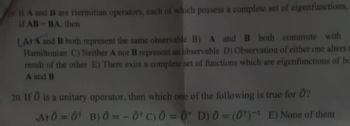Question

Transcribed Image Text:11 A and B are Hermitian operators, each of which possess a complete set of eigenfunctions,
if AB-BA, then
LAYA and B both represent the same observable B) A and B both commute with
Hamiltonian C) Neither A nor B represent an observable D) Observation of either one alters t
result of the other E) There exist a complete set of functions which are eigenfunctions of be
A and B
20. If Ô is a unitary operator, then which one of the following is true for Ô?
A) 0 = 0 B) 0 = -0¹ C) Ô = 0 D) 0 = (0¹)-¹ E) None of them
Expert Solution
This question has been solved!
Explore an expertly crafted, step-by-step solution for a thorough understanding of key concepts.
Step by stepSolved in 4 steps with 4 images

Knowledge Booster
Similar questions
arrow_back_ios
arrow_forward_ios